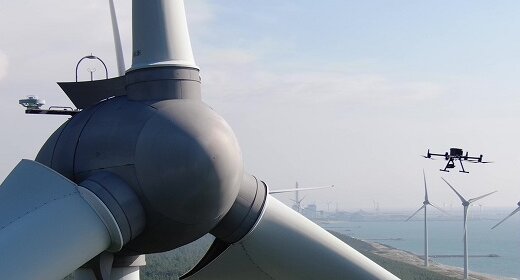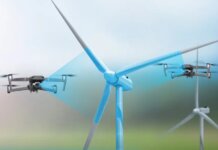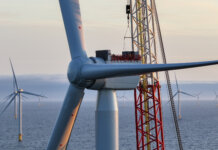Hitachi Power Solutions says it is commencing advanced services that mitigate the risks of wind power facilities by combining AI and other digital technologies with drone technology.
Renewable energy is expected to be one of the prime power sources as Japan is gearing up to achieve carbon neutrality by 2050. In fiscal 2019, renewable energy sources made up 18% of the total electricity supply in Japan. Playing a key role in this shift, wind power has kept a low profile thus far, primarily because of weather conditions and restrictions on locations in Japan. However, as wind power facilities evolve and the level of maintenance services increases, the number of installations has begun to accelerate, albeit gradually, having grown by approximately 50% over the past decade.
Yukihiro Shirahama, a maintenance service engineer of wind power facilities at Hitachi Power Solutions, stresses the importance of keeping rotating blades in proper maintenance: “While power is being generated, the tip of the blades rotates at a speed of 300 km per hour, which makes it very vulnerable to damage. In fact, at various wind farms, there have been cases of dropped or broken wind turbine blades. We too have had such experiences at the facilities we service, in that we have encountered several instances of wind turbine blades being damaged by lightning strikes and typhoon winds.”
To address this shared concern, the Japan Wind Power Association (JWPA) in March 2021 established the Wind Power Facilities – Rotating Blade Inspection and Repair Guidelines. A member of the working group for compiling the guidelines, Hitachi Power Solutions in fiscal 2021 set out to develop a new maintenance service geared specifically towards the guidelines in a bid to ensure greater safety and security at wind power facilities.
When going about designing advanced maintenance services, Hitachi Power Solutions paid particular attention to advancing its maintenance services by integrating inspection using digital technology with maintenance planning and repair work. With SENSYN ROBOTICS Inc., a provider of automatic, drone-based image capture, joining forces as a partner, the development project really took off.
“Using technology they suggested, we used drones to inspect blades on-site on a trial basis,” Shirahama recalls. “Within a couple of hours of arriving at the site for the first time, we were able to fly a drone automatically for inspection. We had wind of 12 m/s at that point. Up until then, we had assumed for some reason that drones were not suitable for inspecting wind power facilities, which are typically located in windy areas. Contrary to our assumption, however, we became confident that there was a good chance of using drones for facility inspection. Then, the project went into full swing from early June 2021.”
Also, previously, technicians would have to manually select photographs out of over 100 per unit in order to determine what state a wind turbine’s blades were in and the extent of damage. For this project, they also developed a data management system which sorts through and classifies the mounds of image data by wind farm or shooting angle. Applying digital data management to inspection, maintenance planning and repair work under a unified system improves work efficiency. Furthermore, amassing data on past damage and repair history also helps to enhance the effectiveness of maintenance planning.
“When we use drones for automatic image capture, needless to say, images are taken from the same position and angle every time,” repair engineer Naoya Kanazawa explains. “We suggested to SENSYN ROBOTICS Inc. that we instead shoot images from five different angles. This is because it can sometimes be difficult to determine the extent of damage from images taken from the four traditional angles, along the X and Y axes, heads-on. Low accuracy in damage assessment can affect choices when it comes to repair work and repair techniques. Our goal for this project was to develop advanced services that cover everything from inspection to repair work, which should allow us to repair and maintain the blades in an optimal manner according to plan.”
Because of the seamless transitions between inspection, maintenance planning, and repair work, this new service was named the Blade Total Service.
“For one thing, we are thinking of further tapping into the strengths of the ‘OT (Operational Technology) x IT (Information Technology)’ formula,” Shirahama concludes. “For example, we are hoping to accumulate more specific knowledge such as the tendency for certain types of damage to turbine blades, as well as tendencies in repair history in order to further optimize our maintenance service. Also, this brand new maintenance service can be applied to not just our facilities, but to facilities from many different suppliers as well, which should allow us to extensively contribute to the expansion of the wind power business in Japan.”




